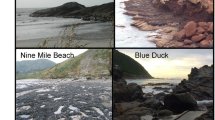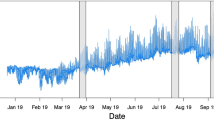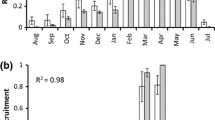Abstract
Closely related species with different physiological tolerances and distributions make ideal systems for documenting range shifts in response to a changing climate. Mytilus edulis, M. trossulus, and M. galloprovincialis are sibling species of marine mussels with distinct biogeographical ranges that are correlated with sea surface temperatures. We determined the scope for growth of these three species at a range of temperatures to determine if energetics could predict their distributions. Scope for growth (SFG) represents energy available for growth and/or reproduction above that necessary for maintenance requirements. The SFG of M. galloprovincialis, the species known to inhabit the warmest habitats, was shifted towards warmer temperatures compared to the other two species, remaining positive until nearly 30 °C. M. edulis, a cold-temperate species, maintained a positive SFG up to 23 °C. M. trossulus, a boreal species, generally was not able to maintain a positive SFG above 17 °C. The warm end of each species’ range correlated strongly with the point at which that species’ SFG became negative in summer and fall. Energetics at cold temperatures did not predict the cold end of the species’ ranges, as there was no clear SFG advantage to explain the dominance of M. trossulus in cold habitats. As sea surface temperatures continue to warm with climate change, the energetics of these three species provide a basis for developing mechanistic models predicting future distribution and productivity changes in mussel populations.




Similar content being viewed by others
References
Anderson AS, Bilodeau AL, Gilg MR, Hilbish TJ (2002) Routes of introduction of the Mediterranean mussel (Mytilus galloprovincialis) to Puget Sound and Hood Canal. J Shellfish Res 21:75–79
Angilletta MJ (2006) Estimating and comparing thermal performance curves. J Therm Biol 31:541–545
Arifin Z, Bendell-Young LI (1997) Feeding response and carbon assimilation by the blue mussel Mytilus trossulus exposed to environmentally relevant seston matrices. Mar Ecol Prog Ser 160:241–253
Bayne BL (1976) Marine mussels: their ecology and physiology. Cambridge University Press, Cambridge
Bayne BL, Worrall CM (1980) Growth and production of mussels Mytilus edulis from two populations. Mar Ecol Prog Ser 3:317–328
Bayne BL, Salkeld PN, Worrall CM (1983) Reproductive effort and value in different populations of the marine mussel, Mytilus edulis L. Oecologia 59:18–26
Branch GM, Steffani CN (2004) Can we predict the effects of alien species? A case-history of invasion of South Africa by Mytilus galloprovincialis (Lamarck). J Exp Mar Biol Ecol 300:189–215
Brannock PM, Wethey DS, Hilbish TJ (2009) Extensive hybridization with minimal introgression in Mytilus galloprovincialis and M. trossulus in Hokkaido. Japan. Mar Ecol Prog Ser 383:161–171
Carlton JT (1985) Transoceanic and interoceanic dispersal of coastal marine organisms: the biology of ballast water. Oceanogr Mar Biol Annu Rev 23:313–371
Carlton JT, Geller JB (1993) Ecological roulette: the global transport of non-indigenous marine organisms. Science 261:78–82
Colt J (1984) Computation of dissolved gas concentrations in water as functions of temperature, salinity, and pressure. Spec Publ Am Fish Soc 14:154
Conover RJ (1966) Assimilation of organic matter by zoo plankton. Limnol Oceangr 11:338–345
Coutts ADM, Dodgshun TJ (2007) The nature and extent of organisms in vessel sea-chests: a protected mechanism for marine bioinvasions. Mar Pollut Bull 54:875–886
Elliott J, Holmes K, Chambers R, Leon K, Wimberger P (2008) Differences in morphology and habitat use among the native mussel Mytilus trossulus, the non-native M. galloprovincialis, and their hybrids in Puget Sound. Washington. Mar Biol 156:39–53
Filgueira R, Labarta U, Fernandez-Reiriz MJ (2006) Flow-through chamber method for clearance rate measurements in bivalves: design and validation of individual chambers and mesocosm. Limnol Oceangr Meth 4:284–292
Fitter AH, Hay RKM (2002) Environmental physiology of plants. Academic, London
Gollasch S (2002) The importance of ship hull fouling as a vector of species introductions into the North Sea. Biofouling 18:105–121
Gosling EM (1984) The systematic status of Mytilus galloprovincialis in western Europe: a review. Malacologia 25:551–568
Grant WS, Cherry MI (1985) Mytilus galloprovincialis Lmk. in Southern Africa. J Exp Mar Biol Ecol 90:179–191
Helson JG, Gardner JPA (2007) Variation in scope for growth: a test of food limitation among intertidal mussels. Hydrobiologia 586:373–392
Hilbish TJ, Koehn RK (1985) The physiological basis of natural selection at the Lap locus. Evolution 39:1302–1317
Hilbish TJ, Bayne BL, Day A (1994) Genetics of physiological differentiation within the marine mussel genus Mytilus. Evolution 48:267–286
Hilbish TJ, Mullinax A, Dolven SI, Meyer A, Koehn RK, Rawson PD (2000) Origin of the antitropical distribution pattern in marine mussels (Mytilus spp.): routes and timing of transequatorial migration. Mar Biol 136:69–77
Hilbish TJ, Carson E, Plante J, Weaver L, Gilg M (2002) Distribution of Mytilus edulis, M. galloprovincialis and their hybrids in open-coast populations of mussel in southwestern England. Mar Biol 140:137–142
Hilbish TJ, Brannock PM, Jones KR, Smith AB, Bullock BN, Wethey DS (2010) Historical changes in the distributions of invasive and endemic marine invertebrates are contrary to global warming predictions: the effects of decadal climate oscillations. J Biogeogr 37:423–431
Hilbish TJ, Lima FP, Brannock PM, Fly EK, Rognstad RL, Wethey DS (2012) Change and stasis in marine hybrid zones in response to climate warming. J Biogeogr 39:676–687
Huey RB, Stevenson RD (1979) Integrating thermal physiology and ecology of ectotherms: a discussion of approaches. Am Zool 19:357–366
Hutchins LW (1947) The bases for temperature zonation in geographical distribution. Ecol Monogr 17:325–335
Inoue K, Waite JH, Matsuoka M, Odo S, Harayama S (1995) Interspecific variation in adhesive protein sequences of Mytilus edulis, M. galloprovincialis, and M. trossulus. Biol Bull 189:370–375
Izem R, Kingsolver JG (2005) Variations in continuous reaction norms: quantifying directions of biological interest. Am Nat 166:277–289
Jansen JM, Pronker AE, Kube S, Sokolowski A, Sola JC, Marquiegui MA, Schiedek D, Bonga SW, Wolowicz M, Hummel H (2007a) Geographic and seasonal patterns and limits on the adaptive response to temperature of European Mytilus spp. and Macoma balthica populations. Oecologia 154:23–34
Jansen JM, Pronker AE, Bonga SW, Hummel H (2007b) Macoma balthica in Spain, a few decades back in climate history. J Exp Mar Biol Ecol 344:161–169
Jansen JM, Bonga SW, Hummel H (2007c) Differential cold-shock resistance among acclimated European mussel populations. Mar Freshw Behav Physiol 40:233–245
Jones SJ, Mieszkowska N, Wethey DS (2009) Linking thermal tolerances and biogeography: Mytilus edulis (L.) at its southern limit on the east coast of the United States. Biol Bull 217:73–85
Jones SJ, Lima FP, Wethey DS (2010) Rising environmental temperatures and biogeography: poleward range contraction of the blue mussel, Mytilus edulis L., in the western Atlantic. J Biogeogr 37:2243–2259
Kabat AP, Phillips RA, Croxall JP, Butler PJ (2007) Differences in metabolic costs of terrestrial mobility in two closely related species of albatross. J Exp Biol 210:2851–2858
Kolar CS, Lodge DM (2001) Progress in invasion biology: predicting invaders. Trends Ecol Evol 16:199–204
Lee SY, Morton BS (1985) The introduction of the Mediterranean mussel Mytilus galloprovincialis into Hong Kong. Malacol Rev 18:107–109
Lowe S, Browne M, Boudjelas S, De Poorter M (2000) 100 of the world’s worst invasive alien species: a selection from the Global Invasive Species Database (IUCN). Hollands, Auckland
Mallet AL, Carver CE (1995) Comparative growth and survival patterns of Mytilus trossulus and Mytilus edulis in Atlantic Canada. Can J Fish Aquat Sci 52:1873–1880
McDonald JH, Koehn RK (1988) The mussels Mytilus galloprovincialis and M. trossulus on the Pacific coast of North America. Mar Biol 99:111–118
McDonald JH, Seed R, Koehn RK (1991) Allozymes and morphometric characters of three species of Mytilus in the Northern and Southern Hemispheres. Mar Biol 111:323–333
Molnar JL, Gamboa RL, Revenga C, Spalding MD (2008) Assessing the global threat of invasive species to marine biodiversity. Front Ecol Environ 6:485–492
Navarro JM, Widdows J (1997) Feeding physiology of Cerastoderma edule in response to a wide range of seston concentrations. Mar Ecol Prog Ser 152:175–186
O’Neill SM, Sutterlin AM, Agget D (1983) The effects of size-selective feeding by starfish (Asterias vulgaris) on the production of mussels (Mytilus edulis) cultured on nets. Aquaculture 35:211–220
Paine RT (1976) Size-limited predation: an observational and experimental approach with the Mytilus-Pisaster interaction. Ecology 57:858–873
Parmesan C, Yohe G (2003) A globally coherent fingerprint of climate change impacts across natural systems. Nature 421:37–42
Pascoe PL, Parry HE, Hawkins AJS (2009) Observations on the measurement and interpretation of clearance rate variations in suspension-feeding bivalve shellfish. Aquat Biol 6:181–190
Pulliam HR (2000) On the relationship between niche and distribution. Ecol Lett 3:349–361
Rawson PD, Hilbish TJ (1998) Asymmetric introgression of mitochondrial DNA among European populations of blue mussels (Mytilus spp.). Evolution 52(100):108
Rawson PD, Agrawal V, Hilbish TJ (1999) Hybridization between the blue mussels Mytilus galloprovincialis and M. trossulus along the Pacific coast of North America: evidence for limited introgression. Mar Biol 134:201–211
Read KRH, Cumming KB (1967) Thermal tolerance of the bivalve mollucs Modiolus modiolus L., Mytilus edulis L. and Brachidontes demissus Dillwyn. Comp Biochem Physiol 22:149–155
Reynolds RW, Smith TM, Liu C, Chelton DB, Casey KS, Schlax MG (2007) Daily high-resolution-blended analysis for sea surface temperature. J Clim 20:5473–5496
Riginos C, Cunningham W (2005) Local adaptation and species segregation in two mussel (Mytilus edulis x Mytilus trossulus) hybrid zones. Mol Ecol 14:381–400
Root TL, Price JF, Hall KR, Schneider SH, Rosenzweigk C, Pounds JA (2003) Fingerprints of global warming on wild animals and plants. Nature 421:57–60
Rosland R, Strand Ø, Alunno-Bruscia M, Bacher C, Strohmeier T (2009) Applying dynamic energy budget theory to simulate growth and bio-energetics of blue mussels under low seston conditions. J Sea Res 62:49–61
Sará G, Reid GK, Rinaldi A, Palmeri V, Troell M, Kooijman SALM (2012) Growth and reproductive simulation of candidate shellfish species at fish cages in the Southern Mediterranean: dynamic Energy Budget (DEB) modeling for integrated multi-trophic aquaculture. Aquaculture 324–325:259–266
Schneider KR, Helmuth B (2007) Spatial variability in habitat temperature may drive patterns of selection between an invasive and native mussel species. Mar Ecol Prog Ser 339:157–167
Sedivy C, Müller A, Dorn S (2011) Closely related pollen generalist bees differ in their ability to develop on the same pollen diet: evidence for physiological adaptations to digest pollen. Funct Ecol 25:718–725
Seed R (1976) Ecology. In: Bayne BL (ed) Marine mussels: their ecology and physiology. Cambridge University Press, Cambridge
Seed R (1992) Systematics evolution and distribution of mussels belonging to the genus Mytilus: an overview. Am Malacol Bull 9:123–137
Skibinski DOF, Beardmore JA, Cross TF (1983) Aspects of the population genetics of Mytilus (Mytilidae; Mollusca) in the British Isles. Biol J Linn Soc 19:137–183
Southward AJ (1958) Note on the temperature tolerances of some intertidal animals in relation to environmental temperatures and geographical distribution. J Mar Biol Ass UK 37:49–66
Suchanek TH, Geller JB, Kreiser BR, Mitton JB (1997) Zoogeographic distributions of the sibling species Mytilus galloprovincialis and M. trossulus (Bivalvia: Mytilidae) and their hybrids in the North Pacific. Biol Bull 193:187–194
Thompson RJ (1979) Fecundity and reproductive effort in the blue mussel (Mytilus edulis), the sea urchin (Strongylocentrotus droebachiensis) and the snow crab (Chionoecetes opilio) from populations in Nova Scotia and Newfoundland. J Fish Res Bd Can 36:955–964
Thompson RJ, Bayne BL (1974) Some relationships between growth, metabolism and food in the mussel Mytilus edulis. Mar Biol 27:317–326
Väinölä R, Hvilsom MM (1991) Genetic divergence and a hybrid zone between Baltic and North Sea Mytilus populations (Mytilidae: Mollusca). Biol J Linn Soc 43:127–148
van der Veer HW, Cardoso JFMF, van der Meer J (2006) The estimation of DEB parameters for various Northeast Atlantic bivalve species. J Sea Res 56:107–124
Varvio S-L, Koehn RK, Väinölä R (1988) Evolutionary genetics of the Mytilus edulis complex in the North Atlantic region. Mar Biol 98:51–60
Wethey DS, Woodin SA, Hilbish TJ, Jones SJ, Lima FP, Brannock PM (2011) Response of intertidal populations to climate: effects of extreme events versus long term change. J Exp Mar Biol Ecol 400:132–144
Widdows J, Bayne BL (1971) Temperature acclimation of Mytilus edulis with reference to its energy budget. J Mar Biol Assoc UK 51:827–843
Widdows J, Fieth P, Worral CM (1979) Relationships between seston, available food and feeding activity in the common mussel Mytilus edulis. Mar Biol 50:195–207
Wilhelm R, Hilbish TJ (1998) Assessment of natural selection in a hybrid population of mussels: evaluation of exogenous vs endogenous selection models. Mar Biol 131:505–514
Wilkins NP, Fujino K, Gosling EM (1983) The mediterranean mussel Mytilus galloprovincialis Lmk. in Japan. Biol J Linn Soc 20:365–374
Acknowledgments
J.P.’s Shellfish, Penn Cove Shellfish and E.S. Maung (University of Delaware) generously provided mussels for physiological measurements. P.M. Brannock, C. Monaco, R.L. Rognstad, K.A. Smith and L. Yamane assisted with physiological measurements. G.T. Chandler, K.M. Washburn, T.L. Richardson, E. Goldman, and B. Bachman provided access to and help with the Coulter Counter. D.S. Wethey helped acquire temperature data and participated in discussions on various aspects of the manuscript. This research was funded by NASA (NNG04GE43G, NNX07AF20G, NNX11AP77), NOAA (NA04NOS4780264), and NSF (OCE1039513, OCE1129401) grants to T.J.H.
Author information
Authors and Affiliations
Corresponding author
Additional information
Communicated by Pete Peterson.
Electronic supplementary material
Below is the link to the electronic supplementary material.
Rights and permissions
About this article
Cite this article
Fly, E.K., Hilbish, T.J. Physiological energetics and biogeographic range limits of three congeneric mussel species. Oecologia 172, 35–46 (2013). https://doi.org/10.1007/s00442-012-2486-6
Received:
Accepted:
Published:
Issue Date:
DOI: https://doi.org/10.1007/s00442-012-2486-6




